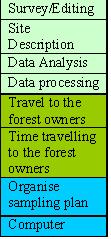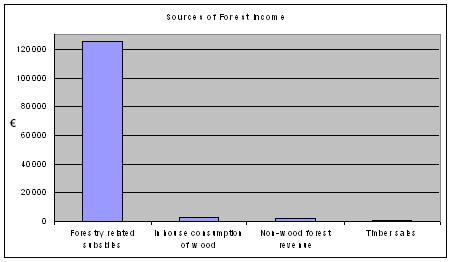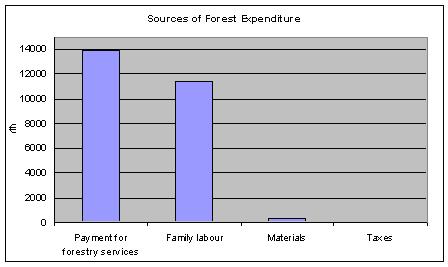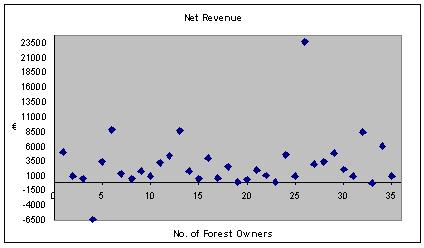Cost
Total Cost €5765
Shared Cost €3928
Marginal Cost €1837
Total Cost/ha €0.16
These cost include:
Results
(FORSEE forest owner survey):
Figure 6.3a: Forest Income (for 2005)
Figure 6.3b: Forest Expenditure (for 2005)
Figure 6.3c: Net Revenue (for 2005)
Remarks
As all but one of the forests is less than 15 years and therefore no harvesting has yet taken place, the main source of forest income is from forestry related subsidies (figure 6.3a). The total forest income generated from forestry related subsidies for the 35 forest owners during 2005 was €125,811. The minimum forestry related subsidy a forest owner received was €326 and the maximum €23,500. These subsidies are directly related to the size of the forest area. The mean annual subsidy was €3595. The only non-wood income was generated from an annual woodcock shoot, in mature woodland over a 2 day period. A small number (17%) of forest owners cut timber for in house consumption. The only income generated from timber sales was from timber harvested for firewood and sold to neighbours. This amounted to very little income generation. The age of the forests range from 2 to 18 years with the exception of a mature old estate woodland (age unknown) and none of the forests had yet been thinned so the potential income generation from non-wood products and timber sales is presently very low. Forest subsidies and any income from timber sales are exempt from taxes in Ireland.
The main source of forest expenditure was payment for forestry services (figure 6.3b). These forestry services included consultancy, contractor labour and fire insurance. The highest single cost was for forest labour on the old estate woodland where a forest worker was employed part-time (6 months per annum) to carry out maintenance work on the woodland such as cutting the paths for the woodcock shoot. Fire insurance was the most frequent payment in forest expenditure. Family labour is a cost that is often unaccounted for in forest expenditure but as seen in figure 6.3b it was the second largest expenditure. Mean expenditure for family labour was €814/forest owner. Expenditure for materials was very low (€340 - 2 forest owners) which could indicate that either the forests are in good condition or that maintenance work is not been carried out. Expenditure for materials was in both cases for fencing materials. It should be noted that a condition of the afforestation subsidy ensures that the condition of a plantation is of a very high standard when handed over by the contactor to the farmer at 4-5 years. This usually results in little subsequent maintenance being required until 1st thinning is completed.
The net revenue of the forest enterprise was in general profitable which was due to the both the afforestation grant and forest subsidies. However two forest owners made a loss due to family labour costs. The mean net revenue of the forest enterprise was €3034. The maximum individual net revenue was €23,900 and 98% of this was from forest subsidies.
Problems and Improvements
The results show the net revenue for the year (2005) may not be reflective of the sustainability of this indicator. A possible improvement could be to assess the net revenue on a 5 year basis or on the term of the forest management plan which would give a more accurate assessment of the income, expenditure and the net revenue of the forest enterprise.
Conclusions
The results would indicate that forest owners were receiving substantial forest subsidies for their forests but that the income level (possibly because of the age of the forest) does not reflect the expenditure level.

Initiative Communaitaire FEDER
INTERREG IIIB Espace Atlantique



